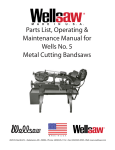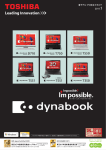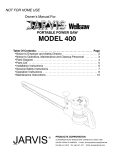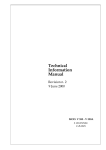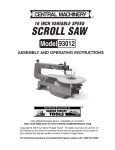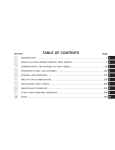Download Carrier 58BD Specifications
Transcript
MODEL 58BD&58BW Parts List Portable/Convertible Manual Bandsaw and Built better to work stronger and last longer Operating & Maintenance Manual REV 131109 2829 N. Burdick rdick St. Kalamazoo, MI 49004 Phone: 269-345-1132 69-345-1132 Fax: 269-345-0095 www.wellsaw.com Index Full Year Limited Warranty Specifications ........................................................... 2 Warranty Info ............................................................ 2 Safety Instructions .................................................... 3 Operation & Maintenance ......................................... 5 Recommended Service Kit ....................................... 7 This WELLSAW is warranted against defects in material or workmanship installed or performed at the factory. Within one year fro, date of purchase, we will free of charge and at our option, either repair or replace any part of this WELLSAW which our examination discloses to be defective because of workmanship or a defect in the material. This warranty does not apply if this WELLSAW has been used in a manner not consistent with its’ design or which has been subject to accident, alteration, abuse or misuse or which fails due to lack of care or is the result of inadequate power supply and specifically does not apply to normal wear parts. THERE ARE NO WARRANTIES WHICH EXTEND BEYOND THE DESCRIPTION OF THE FACE HEREOF. WELLSAW shall not be liable for consequential or incidental damages suffered or incurred with respect to defective materials or workmanship. We do not authorize any person or representative to make any other warranty or to assume for us any liability in connection with the sale of our products other than those contained herein. Any agreements outside of or contradictory to the foregoing shall be void and of no effect. All transportation costs on products or parts submitted to WELLSAW under this warranty must be paid by the user. No products or parts are to be returned without first obtaining permission Parts Drawings & Parts Lists Bed & Leg ............................................................. 8-9 Wheel & Frame ................................................. 10-11 Blade Guide & Gear Box ................................... 12-13 Coolant, Switch & DashPot .............................. 14-15 Service Parts Changes (Before Serial # 22020)..... 16 Switch Box Assembly ............................................. 16 Trouble Shooting .................................................. 17 Electrical Schematic ............................................... 18 Wellsaw® Select-O-Chart........................................ 20-21 Specifications Horizontal Capacity Rectangular .......................................... 9.5” H x 11”W Round .................................................... 9.5”Diameter Flat......................................................................... 12” 45 Degree Angle .............................5-1/2”H x 5-1/2”W Vertical Capacity Work Table ...................................................... 8” x “10 Throat Height .....................................................9-1/2” Throat Depth......................................................6-1/4” Speeds, FPM .......................................... 76, 141, 268 Blade Size ............................ 1/2” x .025” x 7’-9” (93”) Motor ............................................................... 1/2 HP Bed Width ..........................................................8-1/2” Floor to top of bed ................................................. 26” Floor space ................................................... 26” x 54” Height (Frame Vertical)....................................55-3/4” Height (Frame Horizontal) ...............................42-3/4” Approximate Shipping Weight, 58BD ............. 350 lbs Aproximate Shipping Weight, 58BW ..............365 lbs. For Your Convenience When contacting your WELLSAW supplier or the Company for parts or service, it is helpful to have both your saw Serial Number and Purchase Date available. Jot them down her for handy reference. Serial Number: Purchase Date: Additional blades available: 6, 10, 14, 18 & 24 teeth per inch 2 SAFETY INSTRUCTIONS Know your machine, its safe and proper use! DISCONNECT POWER before adjusting or servicing the saw or changing a blade. FOR ALL TOOLS STAY CLEAR of all moving parts. Keep hands and fingers away form the saw blade. KEEP GUARD IN PLACE and in working order. WHEN MOVING SAW, with hinged frame (saw head), secure the head in its down position. REMOVE ADJUSTING KEYS AND WRENCHES. Form a habit. Check to see that all keys and wrenches are removed from the tool before turning the tool on. WHEN CUTTING MAGNESIUM, take special precautions. Use a sharp saw blade, make only dry cuts, prevent chip accumulation, and keep fire-fighting equipment nearby. KEEP WORK AREA CLEAN. Cluttered areas and benched invite accidents. THIS SAW SHOULD BE GROUNDED WHILE IN USE TO PROTECT THE OPERATOR FROM ELECTRICAL SHOCK. AVOID DANGEROUS ENVIRONMENT. Do not use power tools in damp or wet locations. Keep your work area well lighted. CORD CONNECTED TOOLS. If the saw is equipped with an approved 3-conductor cord and a 3-prong grounding type plug, it should only be connected to a properly equipped and grounded receptacle. The green conductor in the cord is the grounding wire. Never connect the green wire to a live terminal. KEEP CHILDREN AWAY. All visitors should be kept a safe distance from work area. MAKE WORKSHOP KID-PROOF with padlocks, master switches, or by removing starter keys form tools. DON’T FORCE TOOL. It will do the job better and safer at the rate for which it is designed Use only a 3-wire extension cord having a 3-pronged receptacle, a 3-pronged plug and ample amperage rating. Replace or repair a damaged or worn cord immediately. USE RIGHT TOOL. Don’t use a tool a or attachment to do a job for which it was not designed. WEAR PROPER APPAREL. No loose clothing or jewelry to get caught in moving parts. Rubber-soled footwear is recommended for best footing. PERMANENTLY CONNECTED TOOLS. The saw should be connected to a grounded, metal-enclosed wiring system or an equipment-grounding conductor should be run with the circuit conductors and connected to the saw’s grounding terminal or lead. USE SAFETY GLASSES. Also use face or dust mask if operation is dusty. To reset the manual starter after a power interruption, return the switch to OFF and press the RESET button before restarting. SECURE WORK. Use clamps or a vise to hold work. Provide adequate support to prevent injury from falling work pieces. 3 MAINTAIN TOOLS WITH CARE. Keep tools sharp and clean for best and safest performance. Follow instructions for lubricating and changing accessories. The work area should be neat, well lighted, properly ventilated and free of pedestrian or vehicle traffic. Ample room is needed for stock handling and storage, the floors must be free of slipping or tripping hazards as many machines have exposed tooling that can be fallen on. DISCONNECT TOOLS before servicing or when changing accessories such as blades, bits, cutters, etc. These items, though they are not specific machine guard needs, are equally important. AVOID ACCIDENTAL STARTING. Make sure the switch is in OFF position before connecting power tools. It is also interesting to note that operators observed and questioned by the survey representatives and employed on some woodworking and metalworking equipment are often new hires with little or no experience with machine operation. This is substantiated by the finding that proper training programs are almost absent from industry (Field Supplement, page 8) and by the fact that the highest percentage of accidents occurs at a young age (see Field Survey Supplement, page 8). The best example of this is with operators of saws where the operation seems self-explanatory through observation. Perhaps the operation is basically simple; nevertheless, operators should be carefully trained and enthusiastically motivated to perform safely. DON’T OVER REACH. Keep proper footing and balance at all times. USE ONLY RECOMMENDED ACCESSORIES. Consult the owner’s manual for recommended accessories. The use of improper accessories may be hazardous. NEVER STAND ON A TOOL. Serious injury can occur if the tool is tipped or the cutting tool is accidentally contacted. CHECK DAMAGED PARTS. Before further use of the tool, a guard, or other part that is damaged, should be carefully checked to ensure that it will operate properly and performed its intended function. Check for alignment of moving parts, breakage, mounting and any other condition that may affect the tool’s proper operation. Any guard or part that is damaged should be properly repaired or replaced. A final observation found through field surveys has to do with the size of the company versus the number of unguarded machines (see Field Survey Supplement, page 2). The smaller the company in number of employees, the larger the percentage of unguarded machines observed. This illustrates a further need for machine guards. This excerpt from a survey report does not necessarily reflect the views and policies of OSHA however it is presented for your consideration in maintaining workplace safety. The age of the operator, the size of the company, and the lack of training programs, along with the investigation of specific machines to identify inherent hazards, establishes a definite need for machine guarding. The fact that a hazard exists and a worker performs in proximity to that hazard will undoubtedly result in an injury. Because of this, the use of machine guards to divorce the operator from the hazard to the highest possible degree is not only desirable but needed. It is the moral responsibility of the employer and expected benefit to the employee to be able to manufacture goods without occupational injuries. From “Machine Guarding Assessment of Need” HEW publication No. (OSHA) 75-173 SUMMARY: The previous information discussed specific machines and their inherent characteristics and hazards. All machines, however, require proper power installation and maintenance. High-speed, rotating cutting tools must be properly sharpened and well balanced to eliminate vibration. Saw blades must be properly sharpened and set to eliminate binding and ensure clean cuts. Any cutting tool that is cracked or chipped must be discarded. 4 Operation & Maintenance READ CAREFULLY The MODEL 58B METAL CUTTING BAND SAW is designed for efficient performance. With proper care, it will give you many years of dependable service. READ THIS MANUAL CAREFULLY BEFORE OPERATING YOUR NEW SAW. After final assembly, each saw is inspected and tested. No adjustment should be needed. This manual has been prepared to assist you in the operation and maintenance of your new saw. If you desire additional information or assistance, please contact your dealer’s service representative. 9. Briefly start and stop motor a few times to make sure blade is riding correctly on band wheels, then tighten blade to proper operating tension. 10. Replace blade guard. 11. Lower frame for horizontal cutting. 12. Check safety bar. Be sure it is in proper position to prevent frame from being raised beyond maximum position when used as a horizontal cutt-off saw. QUICK ACTION VISE The sliding vise jaw is equipped with a ratchet dog arm for quick action and a hand wheel for tightening work in the vise. Excessive pressure is not required to hold material securely in the vise. INSTALLATION Uncrate and check all parts. Report any damage to your carrier and file a Proof of Loss Claim with the carrier. Be sure motor specifications correspond with your power source. Place the saw so that each leg is carrying its share of the load. The 58B Saw can be operated horizontally and vertically. For vertical operation. place frame in upright position, attach the vertical work table and, operate switch manually. FIXED JAW VISE Two pins in the fixed vise jaw assist in the quick relocation of the fixed vise jaw for 90° cutting. For final and accurate adjustment, the blade should be squared with the vise jaw by placing machinist’s square head lightly against the side of the blade and the squares blade against the machined face of the vise jaw. NOTE: These pins must be removed before fixed vise jaw can be turned. For angle cutting, use the clamp bolts to hold fixed vise jaw. Loosen sliding vise jaw and push against fixed jaw vise jaw, then cap screw tightened, leaving vise jaws parallel. OPERATION Do not apply too much feed rate. Start cut carefully and the new blade will last much longer. Make sure all four legs are in solid contact with the floor. Keep blade guide as close to the work as possible. MAXIMUM VISE CAPACITY & 45° ANGLE ADJUSTMENT PLACING BLADE ON SAW 1a. DRY CUTTING MACHINE. Release from safety latch bar and swing frame into vertical position. 1b. MACHINE WITH WET CUTTING SYSTEM. Remove chip pan, then follow instructions in 1a. 2. Open idler wheel hinged guard. 3. Remove blade guard. 4. Turn blade tension wing screw to lower the idler wheel and slide block assembly. 5. Uncoil a 1/2” x 93” blade. 6. When facing cut-off side of machine, blade must travel toward the motor end. 7. Be sure blade teeth point in this direction. If not, twist blade band inside-out. 8. Install blade as follows: a. Place blade between guide bearings and brushes. b. Insert blade into slot between frame and guard. c. Slide blade onto the drive and idler wheels. d. Turn tension wing screw until blade is taut. 1. Remove blade brush assembly from blade guide arm. 2. Remove the two 5/16” cap screws holding guide arm to the frame. 3. Move guide arm back to the next two holes. Replace cap screws and tighten in place. 4. Remove vise jaw pins in fixed vise. 5. Remove 1/2” cap screw from quadrant. 6. Loosen cap screw in center of vise jaw and slide vise toward motor end of machine about 2-1/4”. 7. Replace 1/2” cap screw in tapped holes and tighten lightly. 8. With saw frame in cut-off position, place head of machinist’s square lightly against slot in bed with the blade of square against machined face of vise jaw. Tap lightly with lead hammer until vise jaw is parallel to blade of square. Tighten cap screws. Use a protractor for angle adjustment. 5 DASH POT MAINTENANCE Wellsaws are equipped with a dash pot (frame check) to stabilize the downward travel of the saw frame to protect the saw blade from damage. The action is hydraulic. The flow of fluid being bypassed through an orifice controls the downward stroke of the saw frame. Fill the dash pot to within 1” of top of the bottom of cylinder with Cities Service “Amplex 05” Hydraulic Oil or equivalent. BEFORE MAKING ANY ADJUSTMENTS, ALWAYS TRY A NEW BLADE TO MAKE SURE THE CAUSE OF THE PROBLEM IS NOT A WORN BLADE. Blade guides are provided to hold the blade in both horizontal and vertical alignment. Accuracy of cut depends on proper adjustment of the blade bearings. Check their condition for wear or a tendency to stick. When the blade is moved sideways or with a twisting action, the movement should stop at the bearings and not be transferred beyond this point. FRAME WEIGHT ADJUSTMENT The position of the collar in relation to the spring on the dash pot acts as the frame weight adjustment. The proper frame weight is approximately 10 lbs. and is obtained by positioning the collar 3-3/4” down from the top edge of the upper cylinder to the top edge of the collar. For less frame weight, loosen collar and move downward toward tension spring. Reverse procedure for more frame weight. Too much frame weight will cause the blade to cut crookedly. An eccentric axle is provided on each blade guide. By rotating this axle, the bearing is drawn away from the blade. WHEEL PITCH ADJUSTMENT If the blade runs too low on wheels, it may be because of too much blade tension. Loosen the blade by turning the “T” handle (10) counterclockwise (CCW). The blade must be reasonably tight. If this adjustment does not correct the problem, adjust the wheel pitch. Usually, adjusting the idler wheel will correct the problem. However, if it doesn’t, both idler and drive wheels will have to be adjusted as follows: SWITCH AND MOTOR This saw is equipped with a start-stop switch that automatically shuts off the motor at the completion of a cut when the wheel guard contacts the switch control lever to the desired position for proper shut-off. It is necessary to raise the saw frame clear of the switch control lever before the saw can be started. Thermal overload protection is provided in the motor. Should the motor stop for other than normal reasons, it may be due to overload. After the problem has been corrected, the motor may be reset by following the instructions on the motor name plate. 1. Loosen blade tension until the blade is slack by turning the “T” handle CCW. 2. Raise the frame into the vertical position. See Diagram. 3. Loosen 2 cap screws 7A and 7B 1/2 turn.. Then tighten 2 cap screws 7C and 7D 1/2 turn. 4. Tighten blade by turning “T” handle CW. If the blade then runs in proper position on both wheels, no further adjustment is necessary. SPEED SELECTION If the blade runs back to the flange of the idler wheel and not on the drive wheel, make the following adjustment: Saws are equipped with step pulleys that provide three speeds: 76, 141 and 268 blade feet-per-minute. Change blade speed by loosening wing screw close to the motor pivot. Place belt in desired position, tighten wing screw until belt is snug and lock wing screw with wing nut. FAST speed to cut thin-wall metal, tubing, thin brass or any metal that will not burn teeth. MEDIUM speed on general cutting such as cold rolled machine steels or any metals which require a slow speed on a lathe. Use beeswax when cutting brass. Brass should always be cut with a new blade. If teeth wear unusually fast, use slower speed. Always keep the blade in proper tension. 1. Loosen the 2 cap screws, 22E and 22F, at the motor end of the wheel plate. 2. Tighten the 2 Allen screws, 22G and 22H, about 1/2 turn. 3. Tighten all four cap screws. 4. Start the motor to see if the blade runs back to the flange of the wheel. CAUTION: Too much pitch will wear the wheel flanges and roll over the back of the blade! This problem can usually be determined by the noise of the blade rubbing against the flange. To check further, place a piece of paper between the blade and the wheel. Start the saw. The blade should not shear the paper but just fold it over. If it shears the paper, back off the adjustment a little at a time until proper adjustment is reached. 6 BLADE BRUSHES Blade brushes should be cleaned frequently with kerosene or a good solvent. To take advantage of both rows of bristles, invert blade brushes and install them on the opposite side of the blade. For best results, replace worn, filled or sticky brushes. When bolting brushes to the mounting angles, be sure wire bristles are turned in the same direction that the blade travels. BLADE GUIDE ADJUSTMENT 1. Check the blade fit between guide bearings by grasping the blade between the guide and the band wheel. 2. Twist blade back and forth. 3. If too much clearance is found, rotate the eccentric axle (34), page 12, until the bearing (32) is snug against blade and all clearance has been removed. 4. Check guide bearing (32) with thumb by applying force against bearing. It should be possible to rotate the bearing while it is snug against the blade and all clearance has been removed. 5. When looseness has been corrected, make another cut. If the cut is not straight, further adjustment must be made. 6. Place a square on the cut. Determine if the blade is cutting toward or away from the bed or if it is out of square with the vise. 7. If the vise is out of square, correct this by squaring the vise with the slot in the saw bed. 8 If the cut is out of square on the vertical dimension, correct this by moving the guides either away from or towards the saw bed. This is accomplished as follows: a. Loosen the 2 cap screws (31), which hold the guide (28) to the guide brackets (23 & 37). Hold the guide from twisting and tap it in the desired direction until the blade is square with the saw bed. To do this: 1. Place a spacer between the frame wheel guard and the switch box raising the blade teeth just over the saw bed. 2. Place a machinist’s square on the saw bed and move it to touch the body of the saw blade - making sure it does not touch the blade teeth. 3. Use a feeler gauge, .002” or less, to see that the lade is square from top to bottom. If further adjustment is needed, loosen cap screws on one blade guide and rotate guide so the feeler gauge will not enter at top or bottom. Do not move guide sideways. This may move the blade out of square with the vise. Tighten cap screws. LUBRICATION Correct and adequate lubrication is very important to achieve maximum service. It is imperative that all dust and dirt be removed before lubricating. 7 Marfak Grade “O” Grease, or equivalent, is used in the gear case. Other parts of the saw may be lubricated as follows: 1. Vise adjusting screw. Use a heavy oil or light grease. 2. Keep internal ring gear and pinion well lubricated with a good quality, medium grade, fibrous grease. 3. Wheel ball bearings are sealed and permanently lubricated. 4. For proper motor lubrication, follow the motor manufacturer’s instructions. LUBRICATION SUMMARY GEAR CASE: Service interval; inspect after 3 years and annually thereafter. Lubricant: Mobilgrease XHP220 or equivalent. VISE SCREW, RING GEAR, PINION: Inspect monthly Lubricant: Use Anti-seize on vise screw Use Extreme Pressure Open Gear Lube on ring and pinion gears sparingly. HELPFUL SUGGESTIONS 1. To select proper blade, consider the type of material to be cut as well as to its size and shape. The SELECT-O-CHART is a handy reference guide. 2. Use the correct blade speed and correct pressure for each type of material cut. 3. Always maintain proper blade tension. 4. Lower saw frame carefully so that the blade will start cutting before full frame feed pressure is applied to the blade. 5. Reduce feeding pressure for the first two or three cuts with a new blade. 6. Keep the adjustable blade guide as close as possible to the material being cut. 7. Keep blade brushes in contact with the blade teeth at all times. Recommended Service Kit for Insurance Against Downtime 100406-001 100066-002 M-426 2 years Bearing “V” Belt Blade Brush 6 req’d 1 req’d 2 req’d Bed & Leg Details 14 13 15 12 44 56 58 26 45 18 19 20 10 6 7 9 21 24 48 52 47 49 51 22 5 9 3 8 50 11 8 4 43 42 46 17 16 41 27 36 32 26 43 28 40 2 42 30 53 1 57 58 23 34 14 58 24 34 25 33 14 50 35 37 9 50 9 52 55 24 54 38 8 31 29 39 Bed & Leg Details Always give model number, serial number and part number when ordering parts. 1 2 3 4 5 6 7 8 9 10 11 12 13 A-016 100019-008 100402 102889 M-061B 102890 102957 100053-005 100004-020 120232 100053-002 105847 100004-039 14 100004-037 15 16 17 18 19 20 21 155107 A-031 M-065 A-151 105839 105840 100004-013 22 23 24 25 105845 101750 100025-002 100004-063 26 27 28 29 30 31 100034-003 A-062 100033-023 100017-003 A-013 A-036 HAND WHEEL HEX JAM NUT, 3/4-10 THRUST COLLAR VISE SCREW VISE SCREW NUT VISE RATCHET CLAMP BLOCK ROLL PIN, 3/16 X 1 CAP SCREW, HH, 5/16-18 X 1-1/4 VISE RATCHET DOG ROLL PIN, 3/8 X 2-1/2 MOVABLE VISE JAW CAP SCREW, 1/2-13 X 2-1/2, HEX HEAD CAP SCREW, 1/2-13 X 1-1/2, HEX HEAD VISE WASHER STATIONARY VISE JAW LOCATING PIN CLAMP NUT VISE SLIDE BLOCK VISE SLIDE BLOCK GUIDE CAP SCREW, 5/16-18 X 5/8, HEX HEAD BED TIP OFF BLOCK LOCK WASHER, 5/16 CAP SCREW, 5/16-18 X 3/4, HEX HEAD SET SCREW, 5/16-18 X 3/8 STOP BAR SET SCREW, 3/8-16 X 2-1/2 HEX NUT, 3/8-16 STOP ARM STOP ARM HOUSING 32 33 34 35 36 37 38 39 40 41 42 43 44 45 46 47 100042-017 120209 100025-005 102932 100419-007 120210 102938 100023-005 105826 105818 102886 100034-001 102887 100019-005 102923 100064-001 48 49 50 51 52 102924 102955 100030-004 100050-003 102922 53 101709 54 55 56 120201 101300 100008-010 57 58 120033 100030-007 102931 9 THUMB SCREW, 5/16-18 X 1-1/4 LEG, DRIVE END LOCK WASHER, 1/2 WHEEL AXLE BUSHING (2 EACH) LEG, IDLE END WHEEL SELF-LOCKING NUT, 5/18-11 HANDLE GRIP HANDLE ROD COLLAR SET SCREW, 1/4-20 X 3/16 RATCHET DOG HEX JAM NUT, 1/2-13 TABLE PLATE CAP SCREW, WASHER HEAD, 5/16-18 X 1 TABLE SUPPORT STOP LATCH FLAT WASHER, 5/16 COTTER PIN, 1/8 X 1 TABLE ASSEMBLY (INCLUDES ITEMS 21, 24, 26, 47 & 48) STOP STOCK ASSEMBLY (INCLUDES ITEMS 26-32) AXLE MOUNTING STRAP HEX NUT, 5/16-18 CAP SCREW, 1/2-13 X 2-1/2, SOCKET HEAD LATCH FLAT WASHER, 1/2 WHEEL AND HANDLE KIT FOR OLDER SAWS INCLUDES 35,38,40-42 Wheel & Frame Details 7A 7B 7C 7D 8 7 (4 req’d) 22 (4 req’d) 26 27 21 24 22F 10 22E 22G 22H Wheel & Frame Details Always give model number, serial number and part number when ordering parts. 1 2 3 4 102874 A-046 A-012 100004-013 5 6 7 100025-002 A-010 100004-019 8 9 10 11 12 13 14 15 16 17 18 19 102360 A-009 102896 A-017B 100414-003 105415 105420 100019-011 100065-007 A-017A A-086 100004-053 20 21 22 100025-001 102900 100004-063 23 24 25 26 27 28 100034-003 102903 100023-005 100042-010 100024-001 100846-016 100846-010 FRAME WHEEL SLIDE BLOCK SLIDE BLOCK CAP SCREW, 5/16-18 X 5/8, HEX HEAD LOCK WASHER, 5/16 WHEEL ADJUSTING BLOCK CAP SCREW, 5/16-18 X 1-1/8, HEX HEAD SPACER WING SCREW BLOCK WING SCREW BAND WHEEL, IDLE END BEARING SPACER WHEEL AXLE HEX JAM NUT, 5/8-18 HEX NUT, 5/8-18 BAND WHEEL, DRIVE END RING GEAR CAP SCREW, 1/4-20 X 1, HEX HEAD LOCK WASHER, 1/4 WHEEL PLATE CAP SCREW, 5/16-18 X 3/4, HEX HEAD SET SCREW, 5/16-18 X 3/8 MOTOR SUPPORT SELF LOCKING NUT, 5/8-11 THUMB SCREW WING NUT, 1/4-20 1/2 HP MOTOR 115/60/1 3/4 HP MOTOR 220/60/3 (OPTION) 29 30 101238 100004-012 31 32 33 34 35 36 37 38 39 40 41 102876 100000-017 100063 100218-010 100000-025 102877 105530 105811 105810 102879 100004-026 42 43 100025-003 100004-067 44 45 46 100029-004 100017-003 105423 47 105422 48 49 50 105615 105856 105858 PULLEY MOTOR CAP SCREW, 5/16-19 X 1/2, HEX HEAD WHEEL GUARD MACHINE SCREW, 10-32 X 1/4 THUMB SCREW CLAMP MACHINE SCREW, 1/4-20 X 1/2 BLADE GUARD BELT GUARD ANGLE WHEEL GUARD WHEEL GUARD, DRIVE END WHEEL GUARD SUPPORT CAP SCREW, 3/8-16 X 7/8, HEX HEAD LOCK WASHER, 3/8 CAP SCREW, 3/8-16 X 3, HEX HEAD FLAT WASHER, 3/8 HEX NUT, 3/8-16 WHEEL ASSEMBLY COMPLETE, IDLE END (INCLUDES ITEMS 11-14) WHEEL ASSEMBLY COMPLETE, DRIVE END (INCLUDES ITEMS 12-15, 17-20) DRIVE WHEEL GUARD BLADE GUARD WHEEL AND BLADE GUARD ASSEMBLY (INCLUDES ITEMS 31 AND 49) WHEEL PITCH ADJUSTMENT If the blade runs too low on wheels, it may be because of too much blade tension. Loosen the blade by turning the “T” handle (10) counterclockwise (CCW). The blade must be reasonably tight. If this adjustment does not correct the problem, adjust the wheel pitch. Usually, adjusting the idler wheel will correct the problem. However, if it doesn’t, both idler and drive wheels will have to be adjusted as follows: 1. 2. 3. 4. Loosen blade tension until the blade is slack by turning the “T” handle CCW. Raise the frame into the vertical position. See Diagram. Loosen 2 cap screws 7A and 7B 1/2 turn.. Then tighten 2 cap screws 7C and 7D 1/2 turn. Tighten blade by turning “T” handle CW. If the blade then runs in proper position on both wheels, no further adjustment is necessary. If the blade runs back to the flange of the idler wheel and not on the drive wheel, make the following adjustment: 1. 2. 3. 4. Loosen the 2 cap screws, 22E and 22F, at the motor end of the wheel plate. Tighten the 2 Allen screws, 22G and 22H, about 1/2 turn. Tighten all four cap screws. Start the motor to see if the blade runs back to the flange of the wheel. CAUTION: Too much pitch will wear the wheel flanges and roll over the back of the blade! This problem can usually be determined by the noise of the blade rubbing against the flange. To check further, place a piece of paper between the blade and the wheel. Start the saw. The blade should not shear the paper but just fold it over. If it shears the paper, back off the adjustment a little at a time until proper adjustment is reached. 11 Blade Guide & Gear Box Details 11 12 10 50 9 30 2 8 7 13 47 21 24 6 16 22 5 16 17 17 23 14 25 32 1 34 35 33 3 4 36 15 19 27 26 32 33 49 18 20 28 10 29 30 31 32 35 30 29 33 10 28 34 42 41 31 36 32 33 38 40 39 37 44 45 35 46 17 42 16 43 12 Blade Guide & Gear Box Details Always give model number, serial number and part number when ordering parts. 1 2 3 4 5 6 7 8 9 10 M-013 101291 100068-001 100072-001 100404-002 101343 100056-001 100414-003 100068-002 100034-003 11 12 13 14 15 15A 101292 100066-002 101286 100404-001 101644 100056-001 16 100004-017 17 18 100025-002 100008-061 19 20 21 22 23 101645 100053-005 JK-057 100008-003 102908 105832 105853 120018 24 25 26 27 28 29 30 31 32 102898 105856 105860-001 100024-005 101297 100029-002 100025-001 100004-053 100406-001 GEAR CASE GEAR CASE COVER SNAP RING, 3 REQ’D EXPANSION PLUG BALL BEARING PULLEY SHAFT & PINION KEY - 3/16 X 3/16 X 1 BALL BEARING SNAP RING SET SCREW - 5/16-18 X 3/8 (NOT USED AFTER SN 23053) PULLEY “V” BELT DRIVEN GEAR BALL BEARING DRIVE SHAFT KEY FOR DRIVE SHAFT 1/8 X 1/8 X 3/4 (NOT ILLUSTRATED) CAP SCREW - 5/16-18 X 7/8 HEX HEAD LOCK WASHER - 5/16 CAP SCREW - 1/4-20 X 1-1/2 SOCKET HEAD DRIVE PINION ROLL PIN - 3/16 X 1 SLIDE BLOCK CAP SCREW - 1/4-20 X 3/4 - SH GUIDE BRACKET BEFORE S/N11751 GUIDE BRKT IE S/N 11752-11884 GUIDE BRACKET - IDLE END (SN 11885-23616) GUIDE BRACKET - IDLE END (AFTER SN 23617) WING SCREW MOVEABLE BLADE GUARD ROLLER AXLE - IDLE END WING NUT - 1/4-20 ROLLER SUPPORT FLAT WASHER - 1/4 LOCK WASHER - 1/4 CAP SCREW - 1/4-20 X 1 - HEX HEAD BALL BEARING 33 34 35 36 37 100097-001 101299 101298 101300 102912 105830 120017 38 105842 105842-001 39 105844 105844-001 40 41 42 43 M-426 100073-003 100017-001 100013-011 44 45 46 47 49 100027-003 100147-004 102949 105885 100000-047 102901 101643 105841 105843 101322-001 105591-001 FLAT WASHER ECCENTRIC ROLLER AXLE ROLLER AXLE ECCENTRIC AXLE NUT GUIDE BRACKET DE < S/N 11751 GUIDE BRACKET - DRIVE END (SN -11752 - 23616) GUIDE BRACKET - DRIVE END (AFTER SN 23617) BLADE BRUSH ANGLE-LONG BEFORE S/N 23617 BLADE BRUSH ANGLE-LONG AFTER S/N 23617 BLADE BRUSH ANGLE - SHORT BEFORE SN 23617 BLADE BRUSH ANGLE-SHORT AFTER SN 23617 BLADE BRUSH WELD BOLT - 1/4-20 X 1/2 HEX NUT - 1/4-20 CAP SCREW BUTTON HEAD 10-32 X 1-1/4LOCK WASHER #10 KEPS NUT - 10-32 STATIONARY BLADE GUARD SLIDE BLOCK SHIM ROUND HD MACH SCR 1/4-20 X 2” GEAR BOX ASSEMBLY INCLUDES ITEMS 1-9 & 13-20 DRIVE SHAFT & PINION INCLUDES ITEMS 15, 19 & 20 BLADE BRUSH ASSEMBLY INSIDE INCLUDES ITEMS 38, 41 & 42 BLADE BRUSH ASSEMBLY OUT SIDE - INCLUDES ITEMS 39-45 ROLLER SUPPORT ASSEMBLY DRIVE 1/2” - INCLUDES ITEMS 28 & 32-36 ROLLER SUPPORT ASSEMBLY IDLE 1/2” - INCLUDES ITEMS 26, 28, 32-36 3/4” Blade Guide Option 101322-002 Roller Support Assy Drive 3/4” 105591-002 Roller Support Assy Idle 3/4” 32 100416-001 Side Bearing 4 req’d 26 120234 Roller Axle 1 req’d 35 B-043 Roller Axle 1 req’d 34 B-109 Eccentric Roller Axle 2 req’d 13 Coolant, Switch & Dash Pot Details 4 3 2 20 23 12 12 11 10 1 11 10 13 14 6 8 7 9 33 32 5 27 22 35 24 20 19 21 28 31 18 26 20 49 50 30 25 51 41 40 42 62 47 34 38 43 60 52 63 35 44 46 53 54 36 45 39 37 35 55 56 57 58 59 61 14 Coolant, Switch & Dash Pot Details Always give model number, serial number and part number when ordering parts. 1 2 3 4 5 6 7 8 9 10 11 12 13 14 16 120064 120041 120231 120230 120160-001 120162 101565-009 100000-017 100249-010 102617 100219-001 100220-020 105780 102984 120229 17 120228 18 105584-002 19 100017-001 20 100004-053 21 22 23 24 25 26 27 28 30 31 32 33 34 100851-001 100805-001 105959 100674-006 100866 120211 105889 105961 100755-001 100004-018 100030-004 120217 105828 35 100017-007 CHIP PAN SPLASH GUARD DRIP EDGE DRIP PAN COOLANT TANK COOLANT TANK COVER SCREEN ROUND HEAD MACHINE SCREW COOLANT PUMP ADAPTER HOSE CLAMP COOLANT HOSE, 3/8 X 96” VALVE (USED AFTER SN 23053) COOLANT NOZZLE ASSEMBLY SWITCH BOX ASSEMBLY (INCLUDES ITEMS 18-31 LESS 27) SWITCH ASSEMBLY (INCLUDES ITEMS 18-26) SWITCH LEVER WITH KNOB HEX NUT, 1/4-20 CAP SCREW,1/4-20 X 1, HEX HEAD PUSH BUTTON GUARD RESET SWITCH CLAMP SWITCH BOX COVER TOGGLE SWITCH RELAY COOLANT TANK BRACKET SWITCH BOX CORD & PLUG CORD SET, 115V FOR COOLANT CAP SCRW, 5/16-18 X 1, HEXHEAD FLAT WASHER, 5/16 FRAME RATCHET (USED AFTER SN 23616) FRAME RATCHET (USED UP TO SN 23616) HEX NUT, 5/8-11 36 102885 37 120012 105829 38 39 40 41 42 43 44 45 46 47 48 49 50 51 52 53 54 55 56 57 58 59 60 61 62 120134 105881 102895 101311 100034-025 120133 M-107 120135 100053-010 M-155 N/A 100017-003 M-144 101524 101527 M-166 100070 M-148 100050-002 102918 101777 101523 101776 M-147 100000-025 63 M-301 64 101526 098049-001 PIVOT BAR FRAME PIVOT BRACKET (USED AFTER 23616) FRAME PIVOT BRACKET (USED UP TO SN 23616) LATCH SPRING WITH “S” HOOK STUD FRAME SPRING ANCHOR SET SCREW, 1/4-20 X 3/8 STOP BLOCK WITH SET SCREW COLLAR WITH SET SCREW RELEASE LEVER ROLL PIN, 3/8 X 1-1/2 DASH POT UPPER STUD HEX NUT, 3/8-16 PISTON ROD END OUTSIDE TUBE PISTON ROD CUP LEATHER CUP WASHER SPRING COTTER PIN, 3/32 X 3/4 SPRING WASHER INSIDE TUBE CLAMP WITH BOLT LOWER STUD MACHINE SCREW, 1/4-20 X 1/2, ROUND HEAD DASH POT ASSEMBLY (INCLUDES ITEMS 50-61, LESS 59 & 60) PISTON ROD ASSEMBLY COMPLETE (INCLUDES ITEMS 52-56) DASH POT OIL (FILL TO 1” FROM TOP) Coolant System for Field Installation order Part # 120218 This kit includes all parts to convert a Model 58BD to 58BW 15 58B Service Parts Changes Before 17240 to 21035 Beginning 20855 Beginning 21036 To Serial Number 11751 From Serial Number 11752 To Serial Number 11885 ELECTRICALS 100670-1 (Switch Only) or 102888 Switch Box Assembly 105869 Safe Start Plus and Cord Set 120228 Switch Assembly & 100846-16 Motor 102858 102908 102912 101322 105828 105832 105830 101322 BLADE GUIDES Frame Ratchet Guide Bracket Idle End Guide Bracket Drive End Roller Guide Assembly Frame Ratchet Idle Guide Bracket End Guide Bracket Drive End Roller Guide Assembly 102963 102949 102961 BLADE GUARDS Blade Guard Idle End Blade Guard Drive End Pivot Rod Current Idle Wheel Guard Assembly could replace old assembly using the following parts: To Serial Number 22020 105868 105860 Idle Wheel Guard Assembly Roller Axle 102931 WHEEL KITS Wheel and Handle Kit for field installation 122029 Switch Box Assembly 1. 2. 3. 4. 5. 6. 7. 8. 9. 10. Disconnect power. Remove existing cover. Remove wire nut (A) and add white pigtail with push connector. Cut off red motor wire (B) from both ends of motor cord. Connect black wire (C) from motor and wet saw pigtail (C) to toggle switch terminal (E). Cut off existing terminal on black power wire (D) and replace with push terminal supplied. Connect new white pigtail to relay coil terminal (F). Connect black power wire (D) with new push terminal to relay line terminal (G) Install cover on switch box. Saw operation. Push reset button only after loss of power. Normal saw operation is by toggle switch. 16 Trouble Shooting For Greater Service and Efficiency Careful Operation - Blade Consideration Cutting out of line Too heavy a feed or worn blade Guides in wrong position Set as close to work as possible Guides out of alignment Follow adjustment instructions Set worn on one side of blade Keep brushes clean. Avoid teeth rubbing in cut by applying enough weight so that each tooth is cutting a good chip Starting cut on odd shape where blade does not contact flat surface Stripping teeth Breaking Excessive wear Reduce feed rate by adjusting frame weight or replace blade. Replace worn guide bearings when they begin to show excessive wear Retard feed until blade has a good start in the material Blade teeth too coarse Be sure that two or more blade teeth are in contact with material being cut Hard spots on material Rotate stock, if possible. Do not put new blade in cut at same angle Guides out of alignment Follow adjustment instructions. Blade twisting Adjust guides as close to work as possible. Be sure material being cut is held firmly Lack of blade tension Always keep blade tight Dash Pot malfunction Check hydraulic fluid level and/or condition of cup leather Blade speed too fast. Follow recommended cutting speeds Blade running off Lack of blade tension wheel Improper wheel pitch adjustment Always keep blade tight See instructions for wheel pitch adjustment Always use a light feed on new blades! 17 ELECTRICAL SCHEMATIC 18 19 Wellsaw® Select-O-Chart To assist in selecting the right blade and the right speed for your job! Speed = Suggested blade speed in feet-per-minute Feeding pressure: L = light, M = medium, H = heavy • T = teeth per inch 20 21 The Original........Since 1926 2829 N. Burdick St. Kalamazoo, MI 49004 Phone: 269-345-1132 Fax: 269-345-0095 website: www.wellsaw.com email: [email protected] 22






















